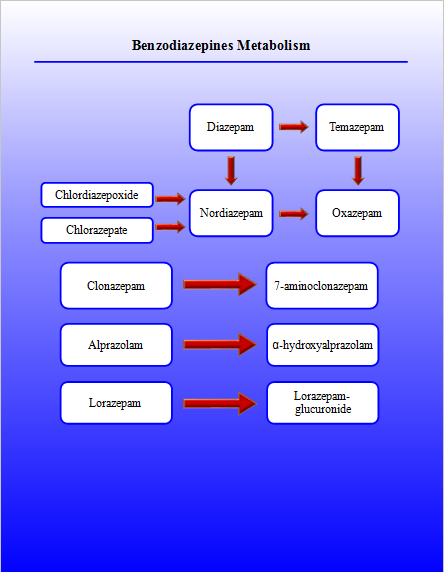Benzodiazepines (Part 3)
Dr. Joseph E. Graas, Scientific Director
Dr. Edward Moore, Medical Director
Urine Testing
Urine screening for the benzodiazepines is accomplished by the same method as the other drug of abuse screens, which is called EIA (ELISA or EMIT) or an enzyme immunoassay. In this method of testing, antibodies are created in an animal source for the group of drugs being analyzed. When the drug is present it attaches to the antibody, the enzyme becomes active, then reacts and turns a color. The intensity of this color is then read and interpreted as to how much drug is present in the sample.
Benzodiazepines undergo complex metabolization as illustrated in Fig 1. With the benzodiazepines, most screening kits detect oxazepam and/or nordiazepam, which are the more frequent metabolites of several of the more commonly abused benzodiazepines that include Valium, Restoril and Librium. The even more commonly abused drugs of Ativan, Klonopin and Xanax do not have those metabolites and the screening tests can produce false negatives. Beck1 stated “Clearly, the EMIT technique does not work reliably for lorazepam, flunitrazepam, and nitrazepam,” which, for the most part, still holds true today. This is extremely important to consider when interpreting your clinical test results especially when benzodiazepine use is still suspected despite a negative screen. In this scenario, it is important to ask for further testing which may include a confirmation test. A way to avoid these false negative on the screen is to add specific individual immunological screens for lorazepam, clonazepam and alprazolam to your selection of tests.
It might be concerning that the antibodies in screening test kits may not bind to all members of the class of drugs you want to detect. What is even more of a concern is when clinical staff are unaware of this issue and assumes the client is negative when they may not be. Opiate screens are likewise a problem in this same manner. This underscores the clinician’s responsibility to be familiar with their laboratory, their testing methods and the limitations of the screens they order.
Criticism
In 2011-12 more than 16 million prescriptions for these medications were written in general practice in England at a cost of over £60m ($100m; €73m) per annum. Benzodiazepines currently account for 62% and Z drugs (zaleplon, zolpidem, and zopiclone) 32% of total prescriptions for hypnotics and anxiolytics in primary care in England.2 Previously, (in 1994) David Blunkett MP (then Shadow Secretary of State for Health, later Home Secretary) had called the widespread prescription of the drug “a national scandal”.
In the USA between 2002 and 2009, “of 3.1 billion primary care visits represented by the survey, 12.6% involved benzodiazepine or opioid prescriptions. The benzodiazepine prescription rates increased by 12.5% per year with co-prescription (of opiates) increasing by 12.0% per year.”3 Professor M.H. Lader, of the Maudsley Hospital, London, has stated: “It is more difficult to withdraw people from benzodiazepines than it is from heroin.” Chrystal Heather Ashton DM, FRCP, Emeritus Professor of Clinical Psychopharmacology at the University of Newcastle upon Tyne, England, said, “it is a tragedy that in the 21st century millions of people worldwide are still suffering from the adverse effects of benzodiazepines.” Outpatient benzodiazepine detoxification in moderate to severe addiction almost always fails. The treatment venue of choice is a controlled medical detoxification in a structured setting.
Legal Status
Flunitrazepam (Rohypnol®) is a Schedule I agent, and not commercially available in the United States. The remaining benzodiazepines are listed in Schedule IV controlled substances.
Figure 1: Illustration of benzodiazepine metabolism
*Arrow indicates metabolic pathways
*Nordiazepam is also a metabolite of halazepam, Medazepam, and tetrazepam

![]()
References
- Olof Beet, Pierre Lafolle, Paul BJemdabI, Stefan Borg,l Gudrun 0deIlus, and Peter Wirbing; “Detection of Benzodiazepine Intake in Therapeutic Doses by Immunoanalysis of Urine: Two Techniques Evaluated and Modified for Improved Performance”; Clinical Chemistry. Vol. 38. No. 2, 1992
- NHS Prescription Services. Central nervous system national charts. NHS Business Services Authority, 2012.
- Ming-Chih Kao, MD, Patricia Zheng, MD2, Sean Mackey, MD PhD2; “Trends in Benzodiazepine Prescription and Co-Prescription with Opioids in the United States, 2002––2009”; (1) Stanford University, Cupertino, CA, (2) Stanford Hospital and Clinics, Palo Alto, CA
